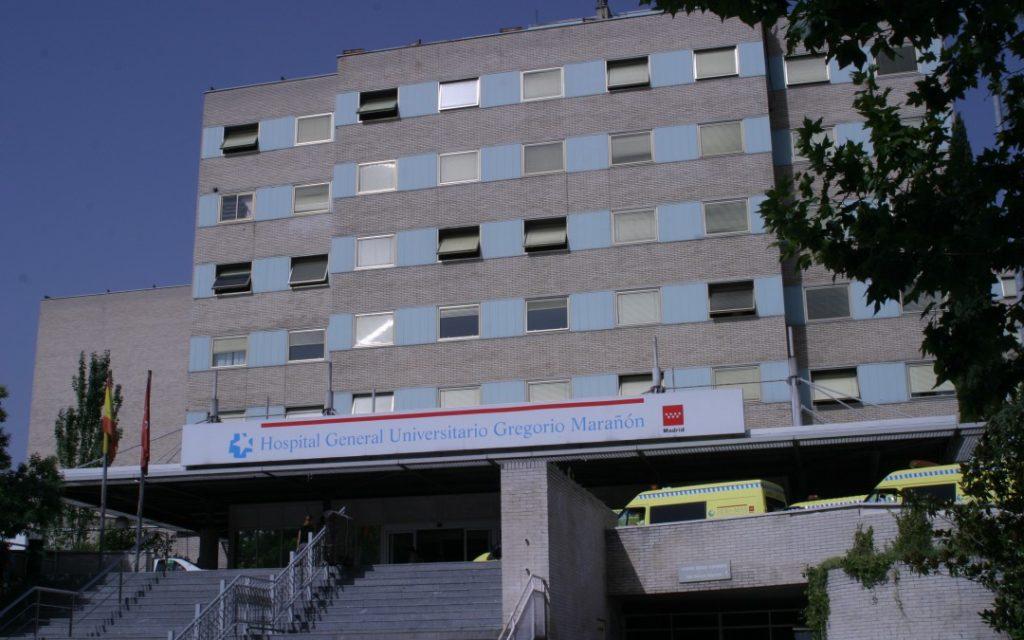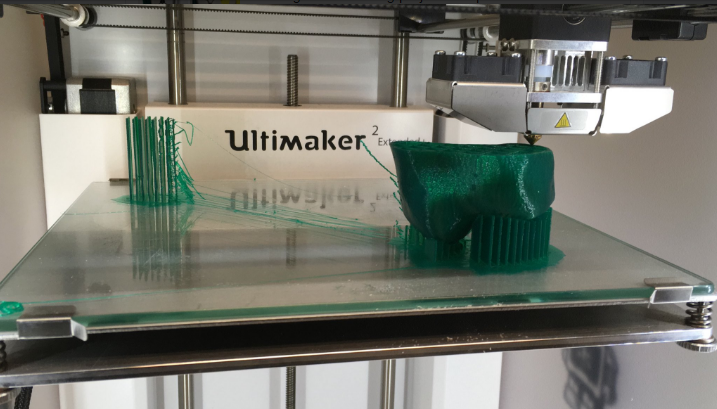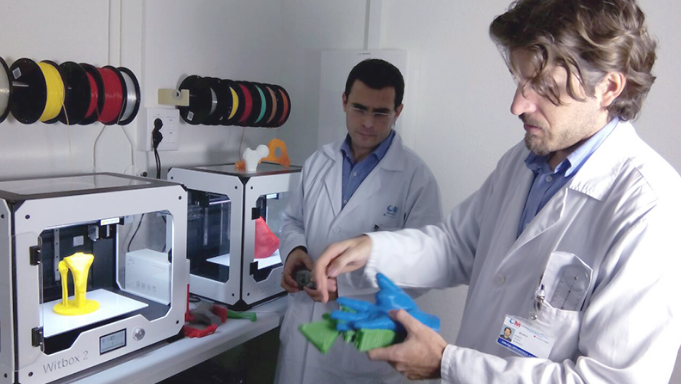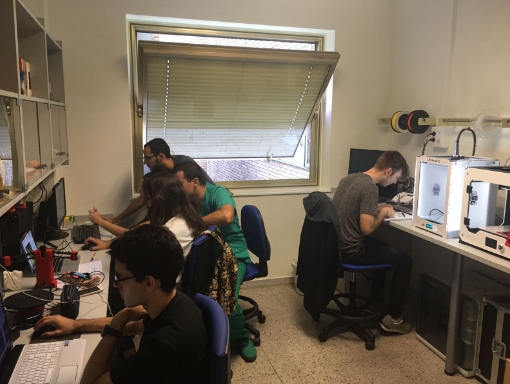Team of Surgeons and Engineers Create FabLab, Accelerate Development of 3D Printing Technology in Madrid Hospital
 The Hospital General Universitario Gregorio Marañón in Madrid is known for being an excellent teaching and research hospital in addition to the great care it provides its patients. It’s also a technologically advanced facility, and that’s thanks in part to a group of surgeons and engineers who have spearheaded the integration of 3D technology into the hospital. Orthopedic surgeon Dr. Rubén Pérez-Mañanes introduced 3D printing to the hospital a few years ago, and now, with the help of some colleagues, he is working to further advance the technology’s applications within the facility.
The Hospital General Universitario Gregorio Marañón in Madrid is known for being an excellent teaching and research hospital in addition to the great care it provides its patients. It’s also a technologically advanced facility, and that’s thanks in part to a group of surgeons and engineers who have spearheaded the integration of 3D technology into the hospital. Orthopedic surgeon Dr. Rubén Pérez-Mañanes introduced 3D printing to the hospital a few years ago, and now, with the help of some colleagues, he is working to further advance the technology’s applications within the facility.
Dr. Pérez-Mañanes, Dr. J.A. Calvo-Haro, and Head of Orthopedic Services Dr. Javier Vaquero have developed a collaborative team of colleagues with diverse skillsets. Working together, they’re facilitating new clinical applications for 3D technology across multiple departments and areas of practice. They’ve also, with the help of biomedical engineer Guillermo Rodríguez-Lozano, started a small FabLab within the hospital, where they’re 3D printing surgical guides, tools and other clinical aids.
One of the most significant uses of 3D printing at the hospital is for the purpose of creating surgical models. We’ve seen, again and again, how lives are being saved through the use of 3D printed models. Many of these cases involve people whose prognosis would have been very bleak if not for the fact that their doctors were able to 3D print exact copies of their affected anatomy and study them closely from every angle, planning the course of the difficult surgeries they were about to attempt before going forward. The Hospital General Universitario Gregorio Marañón is no exception.“Many partners from other clinical departments are approaching to us in order to understand 3D printing technology and its potential uses,” Rodríguez-Lozano tells 3DPrint.com.
“Using open source or free software, the team formed by surgeons and engineers is taking advantage of this technology,” Rodríguez-Lozano tells us. “The doctors say that 3D models give them extra information. Some possible situations could take place into the operating theatre but, now, these situations can be studied previously, reducing the time inside the surgical room and, consequently, the patient’s risk.”
Surgical planning isn’t the only way that 3D printed models are useful, he adds. Doctors are also using the 3D printed replicas of patients’ organs and bones to tangibly show their patients the specifics of their conditions and explain what will take place during surgery or treatment, as well as the possible outcomes. It’s reassuring to patients to be able to actually see what is and what will be happening inside their bodies, rather than relying on their imaginations.

The hospital is working on 3D printing a full skeleton for training purposes. [Image: Guillermo Rodríguez-Lozano via Twitter]
The team is also using 3D technology to fit implants and plates to printed models before fitting them to the patient, as well as printing molds for the creation of silicone phantoms for training – and a lot more.
“Our small FabLab is a continuous brainstorming of ideas and projects. Working together we have begun doing reverse engineering with clinical tools,” Rodríguez-Lozano tells us. “We have scanned the surgical material in order to study their design and planning new possibilities. We print prototypes of all kinds of gadgets that can help us in our daily lives, from splints to immobilize fingers, to boxes and supports for medical supplies, or fasteners to place cameras in the operating room.”Controlling the creation process allows us to make tools that fit our real needs. Being ourselves who build our tools instead of depending on others, and doing it in our environment, gives us greater control of the whole process of care, from diagnosis to intervention. In addition, it supposes a great saving of costs.”Another project in which the ‘maker spirit’ is beneficial to the health is related to the use of 3D printers in regions with few resources or that have suffered the effects of catastrophes or wars. In places where it’s not possible to have all the necessary surgical material and where the needs are very specific, a 3D printer can save costs and solve many medical problems.”
The team is documenting their work on Twitter, using the hashtag #hospitalmarañon3D. You can also follow Rodríguez-Lozano, Dr. Pérez-Mañanes and Dr. Calvo-Haro on Twitter to keep up with the progress the hospital is making. Discuss in the Madrid Hospital forum at 3DPB.com.

Drs. Calvo-Haro (L) and Pérez-Mañanes prepare for surgery with 3D printed surgical models. [Image via Twitter]
Subscribe to Our Email Newsletter
Stay up-to-date on all the latest news from the 3D printing industry and receive information and offers from third party vendors.
You May Also Like
Profiling a Construction 3D Printing Pioneer: US Army Corps of Engineers’ Megan Kreiger
The world of construction 3D printing is still so new that the true experts can probably be counted on two hands. Among them is Megan Kreiger, Portfolio Manager of Additive...
US Army Corps of Engineers Taps Lincoln Electric & Eaton for Largest 3D Printed US Civil Works Part
The Soo Locks sit on the US-Canadian border, enabling maritime travel between Lake Superior and Lake Huron, from which ships can reach the rest of the Great Lakes. Crafts carrying...
Construction 3D Printing CEO Reflects on Being Female in Construction
Natalie Wadley, CEO of ChangeMaker3D, could hear the words of her daughter sitting next to her resounding in her head. “Mum, MUM, you’ve won!” Wadley had just won the prestigious...
1Print to Commercialize 3D Printed Coastal Resilience Solutions
1Print, a company that specializes in deploying additive construction (AC) for infrastructure projects, has entered an agreement with the University of Miami (UM) to accelerate commercialization of the SEAHIVE shoreline...































